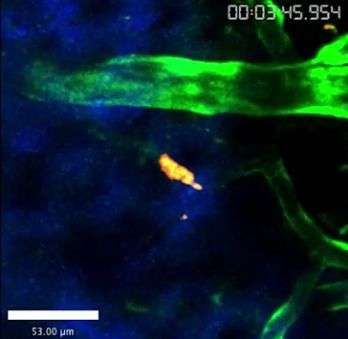Visualizing a parasite crossing the blood brain barrier

An estimated 30 percent of the world's population is chronically infected with the parasite Toxoplasma gondii. Most people live with the infection without noticeable effect, but it can be life-threatening for people with suppressed immune systems, such as people on cancer therapies or who have HIV/AIDS. Pregnant women can also pass an infection to their unborn children, putting the babies at risk of severe neurological disease.
It's known that "Toxo" can affect the brain, even influencing the behavior of its hosts. But scientists have debated exactly how the parasite crosses the blood-brain barrier, a physical obstacle intended to keep pathogens out of the brain.
Now, researchers from the University of Pennsylvania School of Veterinary Medicine and colleagues from across the country have identified how the parasite makes its way in. Using a powerful imaging technique that allowed the scientists to track the presence and movement of parasites in living tissues, the researchers found that Toxoplasma infects the brain's endothelial cells, which line blood vessels, reproduces inside of them, and then moves on to invade the central nervous system.
"Crossing the blood-brain barrier is a rare event in part because this structure is designed to protect the brain from pathogens," said Christopher Hunter, the Mindy Halikman Heyer President's Distinguished Professor at Penn Vet. "And yet it happens and we have now been able to visualize these events. It's something that no one had seen before."
By illuminating the pathogen's path into the brain, the research helps inform what treatment strategies may be most effective at combatting the parasite before it wreaks its worst damage.
The study appears in Nature Microbiology. Hunter was the senior author on the study, which was led by Christoph Konradt, a post-doctoral researcher in Hunter's laboratory.
A few different theories have been considered to explain how Toxoplasma could enter the brain.
Some believe the parasite squeezes between the barrier cells, while others think the parasite goes directly through a cell. Another idea, "beloved of microbiologists," Hunter said, is the Trojan horse hypothesis, in which the parasite hitches a ride across the barrier while hidden inside an infected host cell.
Konradt used Penn Vet's multi-photon microscope, which allows them to peer deep into living tissues without damaging them, to try to witness the parasite's invasion in action. In these studies, they used mice that had been specially bred to express a fluorescent green protein in their endothelial cells. They then infected the mice with modified Toxoplasma that expressed a red fluorescent protein.
After a week, they saw endothelial cells in the brain that were infected, as well as evidence that the parasite was reproducing inside those cells. Two weeks post-infection, they saw that parasites appeared in the brain tissue adjacent to the endothelial cells.
In additional experiments, they were able to visualize parasites bursting out of infected endothelial cells, thereby introducing the parasite into the brain.
The researchers also wanted to revisit the Trojan horse hypothesis, to see if, as had been proposed, infected monocytes, a type of immune cell, might be responsible for carrying the parasite into the brain. To test this, the team infected monocytes with a form of Toxo, labeled red, that can't reproduce, then introduced those cells into mice. If the monocytes were indeed acting as a Trojan horse, the scientists would expect to see the parasite breach the blood-brain barrier. But they only saw infected cells within blood vessels, and these cells were not able to cross the blood brain barrier.
To further illuminate the mechanism by which Toxo infects and disseminates through the body, the researchers looked specifically at levels of free parasites, that is, parasites that had not already infected or become engulfed by a host cell.
They were surprised to see that a significant portion, around a third of the mouse's total parasite load, existed as free parasites in the blood.
"I think we expected to see a small number of parasites outside cells, because they have to come out to move from cell to cell," Konradt said. "But I don't think anyone had fully appreciated the sheer number of parasites that are free and able to infect other cells in the vasculature."
This presence of free parasites was, however, transient. By 10 days after infection, most mice had no free parasites in their blood.
"From a treatment perspective," Hunter said, "that means if a pregnant woman gets infected for the first time, there is a fairly short period of time when the parasite can cross the placenta and affect the fetus. That tells us that targeting these stages in the blood during this narrow window could be effective at preventing congenital transmission."
As a final test to see whether parasites could directly access the brain from the blood, the researchers infected mice with a mixture of normal parasites and mutants that was unable to reproduce, each labeled in different colors. They then showed that only the normal, reproducing parasite made its way into the functional brain tissue.
"This shows that the parasite has to replicate in order to spread from the blood into other tissues," Konradt said. "That could mean a drug that blocks replication could be effective at preventing dissemination."
The team's findings suggest that the current theories about how Toxoplasma crosses the blood-brain barrier are probably not the main way the brain is infected. Rather, parasites move directly from the blood into endothelial cells, where they replicate, cause the cell to burst and then infect neighboring brain cells.
Beyond its implications for Toxoplasma infections, the research may give insights into how other viral, bacterial and parasitic pathogens may move from the blood into the brain.
"Toxo is a really nice model for studying vascular immunity in general," Konradt said.
More information: Endothelial cells are a replicative niche for entry of Toxoplasma gondii to the central nervous system, Nature Microbiology, DOI: 10.1038/nmicrobiol.2016.1
Journal information: Nature Microbiology
Provided by University of Pennsylvania




















